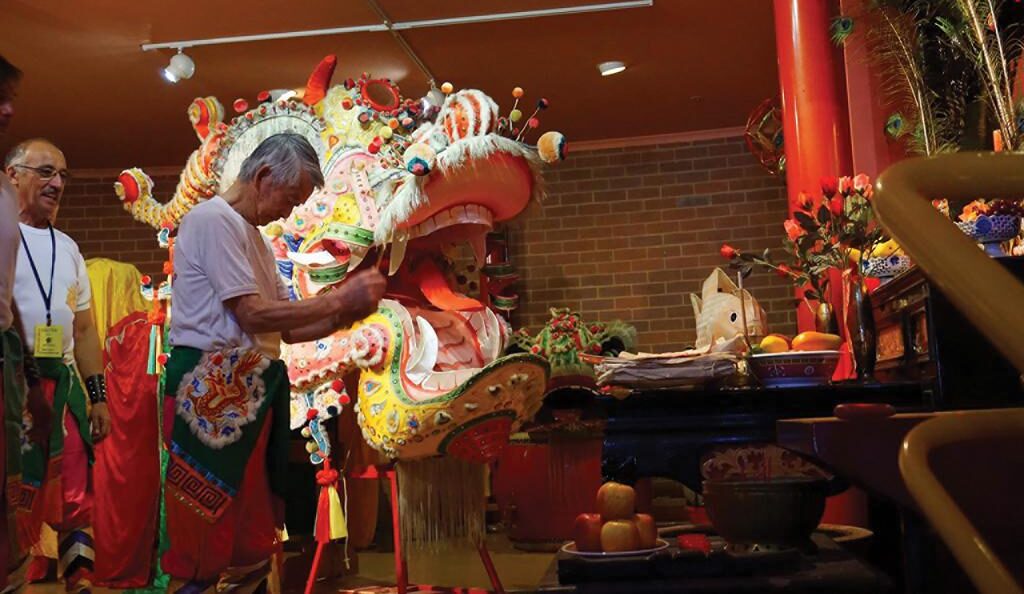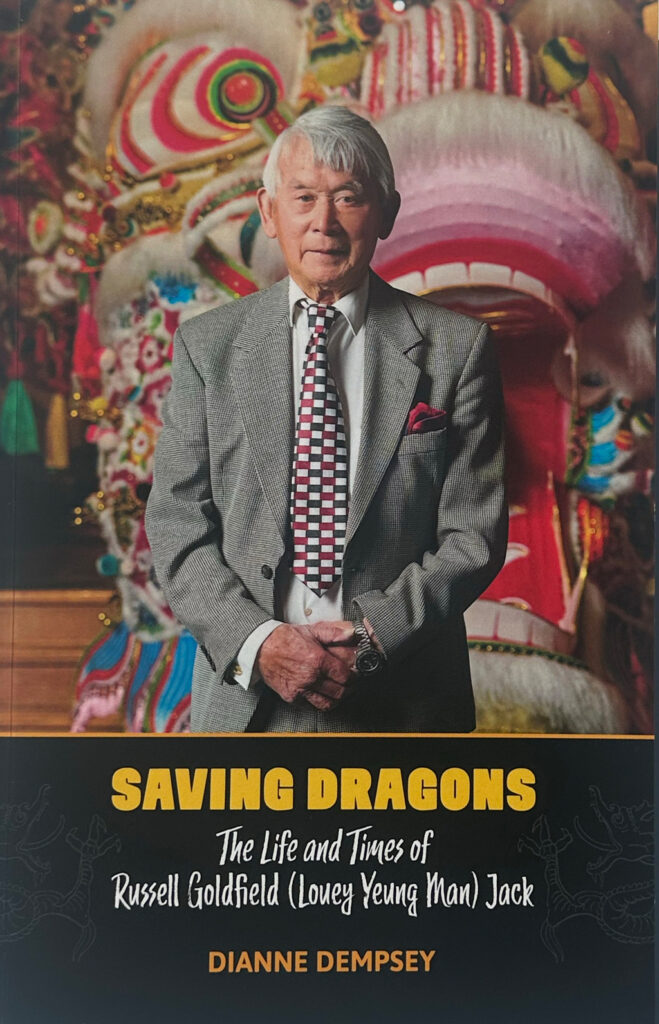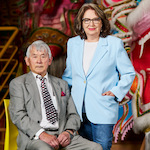
Offerings and blessings to the Chinese gods and Sun Loong 新龍 (New Dragon). Russell with Loong.
Russell said that Sun Loong was his favourite dragon. Each year, in order to carry him, he brought ‘Aussies’ and Chinese together. Courtesy 雷 Jack Family
Dianne Dempsey’s biography of Russell Jack reveals how caring for the dragon was a way of sustaining a Chinese diaspora culture.
Preserving culture, when you are a stranger in a strange land, is a way of preserving your own identity.
Loong, which is Cantonese for ‘dragon’, was Russell’s first dragon. Thought to be the oldest complete Golden Dragon in the world, he was originally 60 metres long. (The head of the Golden Dragon in Ballarat, Victoria, is slightly older but he is incomplete). Built in the early 1890s, under the Qing Dynasty, Loong represents an embodiment of the emperor himself, as shown by his five claws. He has bones of bamboo, scales of colourful silks and thousands of hand-cut mirrors. Unfortunately, when there was a fire at the turn of the 20th century, part of his body was burnt. Now, he is just over 30 metres long. Whereas once it took up to 50 dragon carriers to carry him, that number is now reduced to some 40 people. It takes a team of five or six people to carry his head which weighs 21 kilograms.
The Chinese have participated in the Bendigo Easter Fair since the 1870s and a dragon was included in 1892. Although historians aren’t sure if the original dragon was Loong, we are certain that he appeared in Melbourne in 1901 to help celebrate Australia’s Federation – which is something of an irony, as it was Federation that precipitated the White Australia Policy.
An important way in which the Bendigo Chinese community rode the waves of animosity, perpetrated by the enactment of the White Australia Policy, was through the Easter Fair, when the European communities cheerfully participated in the procession alongside the Chinese.

Sun Loong 新龍 (New Dragon). Russell holds the unparalleled distinction of having paraded with and appeared alongside Sun Loong more times than anyone else in this dragon’s parading history. (L to R) Edsell, Keenan, Roger, Russell and Tyrone Jack. Courtesy Bendigo Chinese Association AP1364.6
Dragon-carriers traditionally throw plenty of crackers about, to keep Loong on his toes and add to the excitement of the procession. Russell said that one year his brother Keith accidently dropped a handful of live crackers down the front of his shirt. His brothers, of course, thought this was quite hilarious as Keith jumped around swiping away the crackers. Not so funny is the story of Lyle Lougoon, who one year dropped a stick of incense into the bag of crackers he was carrying. Seriously burnt, he was rushed to hospital.
Throughout Russell’s childhood, Harry would take him and his siblings own to the Bendigo Chinese Association rooms in Bridge Street, commonly known as Chinatown. Here the family would set about unpacking the many camphor boxes in which Loong was stored. In those days, Loong didn’t have the luxury of spreading himself out, of being permanently on display, as he does these days in the museum that Russell was to build for him.
Russell recalls that they would start the business of building Loong in January, and work every weekend through to Easter. Carefully and patiently, they would join the bamboo frames, unpack the scales and hang them on his long silk cloth, like an undergarment. They would then use string and wire to tie the scales to the cloth. The children were told not to use knots when they tied the string, as they would cause Loong pain. There is no doubt that the Chinese community thought of Loong and the other dragons that followed him as living entities.
In those days, in the 1930s through to the late 1960s, it was mainly Harry, the children and Gladys’s brother Ernie who meticulously reconstructed Loong. Russell’s father and uncle learnt how to care for Loong from elders such as George Gong and Louey Wee Hee. After Loong was assembled, members of the wider Chinese community would then prepare the rest of the regalia, bring out the costumes and participate in the Easter ceremonies.
Along with Loong, the Chinese imported brilliant costumes based on operatic characters such as princesses, emperors and generals. These elaborate, finely sewn costumes would later be saved from deterioration by Russell’s wife, Margaret Joan Clarke (commonly referred to as Joan).
Harry and the other elders who attended the Chinese Association rooms would talk to the children as they worked. Russell recalls that they told him about three species of Chinese dragons, of which Loong was the most powerful. He is the spiritual dragon who produces wind and rain. He can fly through clouds and produce rain, watering the crops. So while dragons are often portrayed as sinister, life-threatening creatures in the West, in Chinese culture Loong has a more benign presence. And after all, he was a vegetarian, so the children were safe.

About Dianne Dempsey
 As a freelance journalist of many years, Saving Dragons has been one of the most rewarding projects I’ve worked on. Based in Bendigo, I’ve written features, opinion pieces and book reviews for local outlets as well as the metropolitan newspapers. I regularly write for the Bendigo Magazine, where I profile outstanding local artists.
As a freelance journalist of many years, Saving Dragons has been one of the most rewarding projects I’ve worked on. Based in Bendigo, I’ve written features, opinion pieces and book reviews for local outlets as well as the metropolitan newspapers. I regularly write for the Bendigo Magazine, where I profile outstanding local artists.


